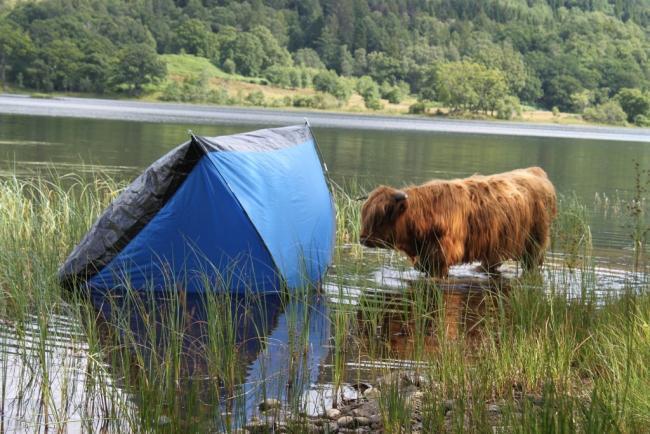This is a guest post by SUNY Oswego student, Noah Blake, who took the course “US National Parks Through Media.” Noah graduates in May, 2019 with a major in Broadcasting and Mass Communication and a minor in Sustainability Studies.
By: Noah Blake
May 4, 2019

Pictured: Old Faithful Geyser at Yellowstone National Park.
The United States has designated 418 areas as national parks. From over-visited parks such as Yosemite with over 4 million visitors in California to under-visited parks like Isle Royale National Park in Michigan with only 26,000 visitors annually, leisure has pros and cons in all of the National Parks. Leisure can be interpreted differently by many, but most of the National Parks offer a wide variety of different things to do such as hiking, camping, white water rafting, and so on. These type of rigorous activities are becoming more and more popular, which could be beneficial in that the parks become top attractions for visitors, which in turn potentially decreases the benefit when viewed through environmental conservation.
Pros and Cons for larger National Parks
Many of the larger National Park benefit by offering leisure to its visitors in the following ways:
- They earn high revenues from tourists who not only just visit the park, but also the tourists that participate in other activities within the park. i.e. ice skate in Half Dome Village in Yosemite National Park.
- Visitor spending creates many jobs. In 2015, visitor spending at Yellowstone secured almost 8,000 jobs at the park alone.
- Surrounding communities thrive as well especially ones that supply lodging, eateries and more.
- The monies that the parks make help preserve protected areas within the park as well as other nearby communities. An example of this can be seen out in the West. According to headwaterseconomics.org, there are, “276 non-metro counties in the 11 contiguous western states: Arizona, California, Colorado, Idaho, Montana, Nevada, New Mexico, Oregon, Utah, Washington, and Wyoming,” all of which have at least some sections of some of the larger national parks.
There a lot of disadvantages for National Parks as well. These include but are not limited to:
- People wandering into areas that are off the “beaten track” and getting lost, injured, or even killed in some cases.
- Since many of the Western iconic parks, such as Zion, Yosemite, Yellowstone and Joshua Tree, are experiencing surges in visitor attendance, they are facing growing problems of vandalism, littering, tampering, etc.
- Growing number of infrastructure problems such as inadequate visitor centers, narrow entry lanes into the park, and so on, are causing parks to overcrowd in specific, high-trafficked areas.
- Invasive species are also taking over due to climate change which can be related to overpopulation, air pollution and “hitchhiker” pests, which tag along with the human guests on their clothing, firewood, and marine vehicles.

As for the smaller national parks, many of them could benefit from offering leisure for the following reasons:
1. It would help provide tourists with other options other than just being limited to walking around/hiking short trails. Parks such as Fort Stanwix pictured below and other national parks that have monuments rather than trails have different forms of visitor experiences. For example, Fort Stanwix offers visitors to watch reenactments of the battle fought there, attend special events and participate in other history programs provided by the park.
2. Offering other activities would also help boost the revenue for the parks. They can use those funds to help broaden their audiences by expanding their media reach. For instance, they can make television commercials, online promotions, etc.
3. Another way smaller parks could use their revenue is towards maintaining and preserving the park. Even though this is being done already, it would be helpful as well to hold more fundraising events especially for the parks that are struggling to stay open to the public. An example of of this is seen with Acadia National Park. This national park is a decent size but is having a hard time keeping up with the overcrowding and maintenance of the park. Some areas are experiencing erosion along the cliffs, sea level rise, etc.

Just like the larger parks, smaller park could also experience some disadvantages as well
1. One issue that smaller parks can run into is overspending on leisure and then not having enough annual attendance of visitors. This could lead to problems such as, lack of funds to keep the park in operation, budget cuts, employees not receiving adequate pay, layoff of employees, etc. Going back to Acadia National Park in Maine. As the amount of leisure, the park is trying to accommodate guests by expanding thing such as parking, transportation to sites in the park, etc.
2. Another disadvantage could be a surplus of visitors which leads other problems more widely recognized parks face such as degradation due to human impacts like littering, vandalism, etc.
3. In some cases, overcrowding could lead to less recognized parks being understaffed to provide tours, enforce park regulations, and also availability of staff during emergencies.
In closing, leisure in National Parks is something that just about every visitor would like to take advantage of, but at what cost? Often times environmentalists say that we are “loving the parks to death”. There are a lot of ways that national parks could benefit from providing a wide range of activities for visitors. It promotes tourism which helps boosts its economy for the park itself and surrounding nearby communities that provide lodging, restaurants, shopping, etc. There are also disadvantages for a lot of these parks as well when leisure is offered such as human impact such as tampering, vandalism as well as littering. Leisure is a complicated element in the mix of the park’s goals and mission to preserve the land for future generations.

